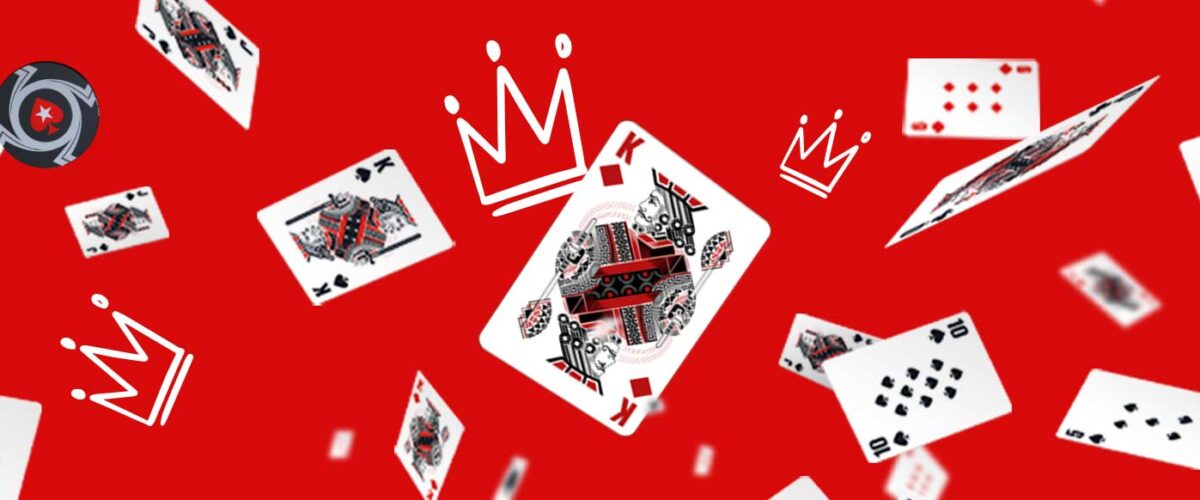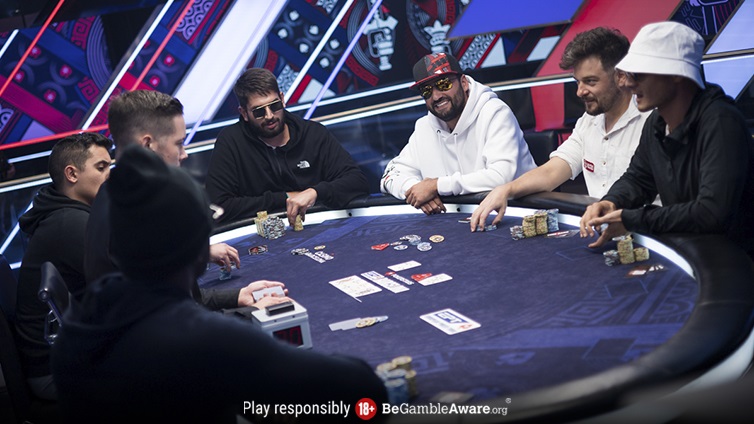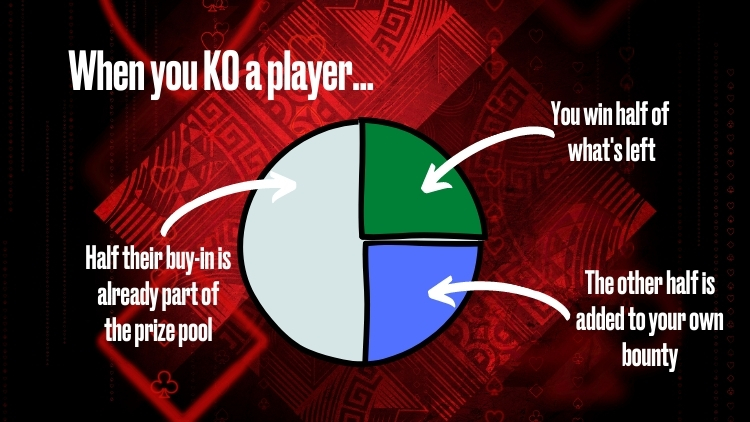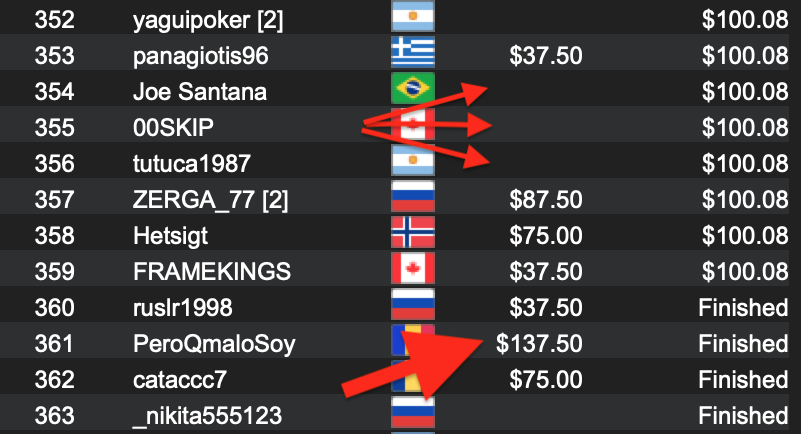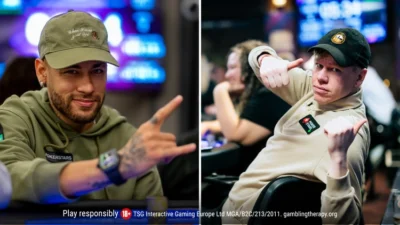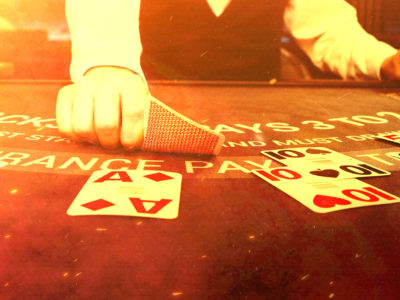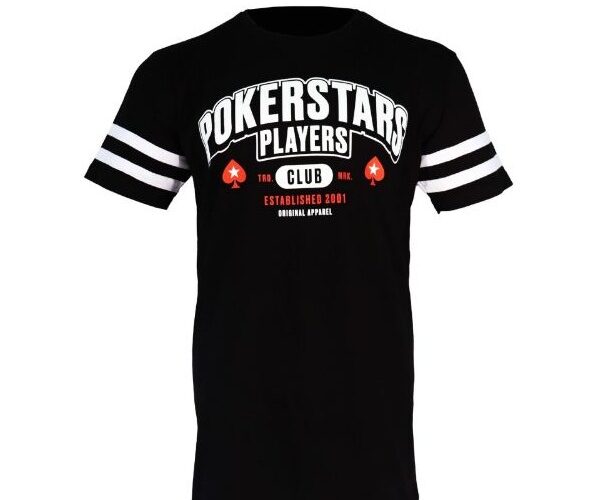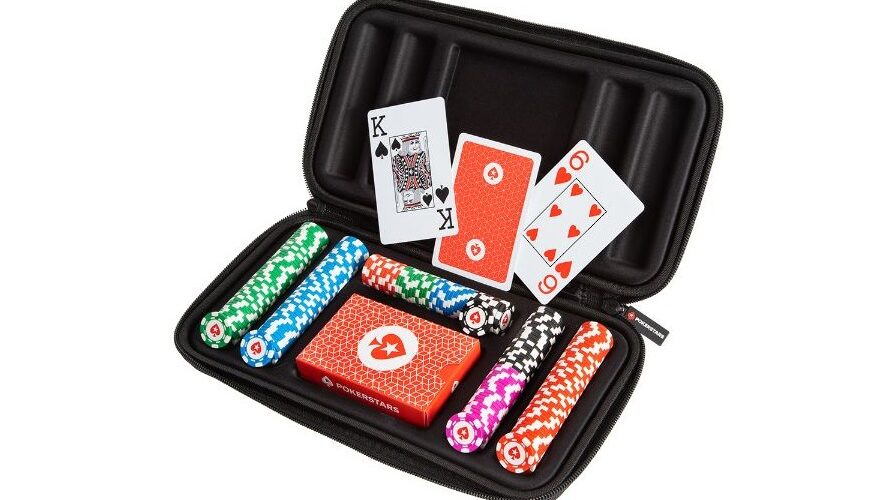Table of Contents
Last updated June 2024…
Do you know your KOs from your PKOs and your Mystery Bounties from your TKOs? No? That’s fine. Just read on and we’ll reveal just exactly what they all are.
Before you launch into any upcoming Bounty Builder Series or Mystery Bounty Series, it is probably a good idea to get a firm grasp on the different types of knockout tournaments.
So what is a PKO tournament? What’s a PKO got that a KO hasn’t? And how do things change again in a TKO or Mystery Bounty?
It’s easiest to start with a look at straight Knockout (KO) tournaments. These used to be a thing before PKOs appeared on the scene and made everything more exciting.
WHAT IS A KO TOURNAMENT?
In a Knockout tournament, a player’s total buy-in is divided into two portions. Each going towards a separate section of the prize pool.
One portion (usually the largest) goes into the regular prize pool. That is paid out incrementally to the top finishers in the event, just as in any “normal” tournament. The second portion goes into the bounty pool.
Each player has a cash bounty on their head, and this bounty is awarded to the opponent who knocks them out. It’s that simple. In essence, a knockout tournament offers bonus cash payments to players for eliminating their opponents. These payments are fixed in size.
Here’s an example
For example, in a KO tournament with a $27 buy-in:
$20 might go into the regular prize pool
$5 becomes a bounty on the player’s head
(The remaining $2 is the entry fee, or “rake”.)
This tournament might be advertised with the entry fee of $25 + $5 + $2.
If Player B knocks out Player A, Player B is awarded Player A’s $5 bounty. It goes straight into Player B’s account, and they get an immediate return on their tournament play.
Eventually, Player C might knock out Player B. In that case, Player C then gets Player B’s $55 bounty. Player C might also go on to knock out Player D, Player E and Player F, for which he or she gets another $15 (or $5 per player).
If Player C then goes on to make the money in the tournament, he or she will also get a prize based on their finishing position. And dependant on the pre-published payout structure.
In the final reckoning:
Player A will end with nothing.
Player B will get the $5 earned for knocking out Player A
Player C will get $25 in knockout payments (for eliminating Player B, Player D, Player E and Player F) plus the prize for their finishing position.
It’s worth remembering that the bounty is only paid to the player who wins the very last of an eliminated player’s chips. It doesn’t matter if Player Z wins a huge pot and leaves an opponent with one big blind. Player Z won’t win the bounty. The bounty goes to the opponent who snags that last chip and causes the actual elimination.
WHAT IS A PKO TOURNAMENT?
A lot of what happens in a knockout tournament happens in a Progressive Knockout (PKO) tournament too. But there’s a notable twist in the way bounty payments are accumulated.
To recap: in a KO or a PKO tournament, one portion of a player’s buy-in goes into a prize pool to be awarded incrementally to the top percentage of the finishers, just like a “normal” tournament. The other portion goes into a bounty pool.
In a PKO tournament, it’s most common for these two prize pools to be equal. Meaning half of a player’s buy-in goes to the “regular” prize-pool and half goes to a bounty pool.
Here’s an example
For example, in a PKO tournament with a $109 buy-in:
$50 would go into the regular prize pool
$50 would go into the bounty pool
(The remaining $9 is the entry fee.)
Every player therefore begins the tournament with a $50 bounty on their head.
Here’s where it gets interesting:
If you knock out an opponent in a PKO tournament, half of their bounty goes straight into your account as a cash prize. But the other half is added to your bounty.
It means that the more players you knock out, not only do your earnings increase, but also the target on your head grows bigger.
This is what’s meant by “Progressive”. Much like a spiralling jackpot on a Vegas slot machine, a player’s bounty in a PKO event grows progressively bigger as the tournament goes on.
For example, if Player B knocks out Player A, Player B gets a $25 cash prize, while his or her bounty also increases by $25. Player B’s bounty would therefore be $75 after this encounter (the $50 on their head to start with, plus the $25 for knocking out Player A).
If Player C then knocks out Player B, Player C gets a cash payout of $37.50 (i.e. half of Player B’s $75 bounty). But his own bounty increases by $37.50 too.
If Player C then goes on to knock out Player D, Player E and Player F too, he picks up half of their bounties as immediate cash payments. But also sees his own bounty grow significantly.
What happens if you win?
If you happen to win a PKO tournament — i.e., nobody ever knocks you out and therefore nobody wins your bounty — you get to keep your own bounty.
It can often be absolutely huge. And in many cases will be bigger than the money you win from the “regular” prize pool. In Fig. 1, below, “Doktor-4ik20” won the tournament and had a bounty haul of $13,610.33, which will include his own bounty.
“UltimatChief” took only $2,240.80 in bounty payments because a large chunk of his went to Doktor-4ik02 at the point of the final elimination.
The tournament lobby of a PKO event shows prizes like this, in two columns: a player’s bounty haul in one and their “regular” prize in the other
Some players can finish high up in the rankings but have nothing in the bounty column, if they didn’t knock out anyone else (see players “Joe Santana”, “00SKIP” and “tutuca1987” in Fig 2, below). While others might be eliminated before the bubble, but still make a profit from the tournament if they knocked out a lot of high-value opponents (see “PeroQmaloSoy”).
5 REASONS TO TRY PROGRESSIVE KO TOURNAMENTS
Finally, one last effort to persuade anyone who might still be on the fence about KO tournaments.
If you’re curious but need a little more information about why you should play, the folks over at PokerStars Learn might be able to persuade you.
You can look around the PokerStars Blog, and PokerStars Learns for plenty of reasons to play. But PokerStars Learn got it down to five.
It’s not about the prize money, although the $25 million guaranteed will ensure some big payouts along the way…
It’s not just that you don’t have to make the money bubble to come away with prize money, although we think that’s one of the coolest things about Bounty events.
As they Pete Clarke of PokerStars Learn puts it,
“For tournament players, the grind can often feel like a volatile rollercoaster of long hours and little downtime. One type of tournament that will definitely spice up your poker calendar is the progressive knockout.”
So here they are.
- Reduced Variance
- A more eventful ride
- Empowerment
- An exhilarating late game
- Less painful bust outs
We admit it. We’ve always found that last one suits our playing styles perfectly.
Find out more: 5 reasons to try progressive KO poker tournaments.
WHAT IS A TKO TOURNAMENT?
Total Knockout (TKO) tournaments are a relative newcomer to the scene. But with several usually on a Bounty Builder Turbo Series schedule, it’s worth a quick look at these too.
It’s actually pretty easy to figure out: in these tournaments, 100 percent of a player’s buy-in goes into the bounty pool. There’s no regular prize pool, and players start with their entire buy-in on their heads as a bounty.
If you knock someone out, you get half of your opponent’s bounty as a cash prize immediately. The other half goes into your bounty, much like with a regular PKO tournament.
The obvious major difference is that there’s no such thing as a bubble, or a regular prize pool. All the money awarded goes in bounties.
This can mean that some players finishing high up in the rankings might get a very small payout, if they knocked out relatively few opponents. While a player low down in the rankings could get much more, if they knocked out numerous high-value opponents.
TKO events are most often played heads-up in the Zoom format. That means you bounce from table to table and opponent to opponent, facing only ever one player at any time.
HOW IS A MYSTERY BOUNTY TOURNAMENT DIFFERENT?
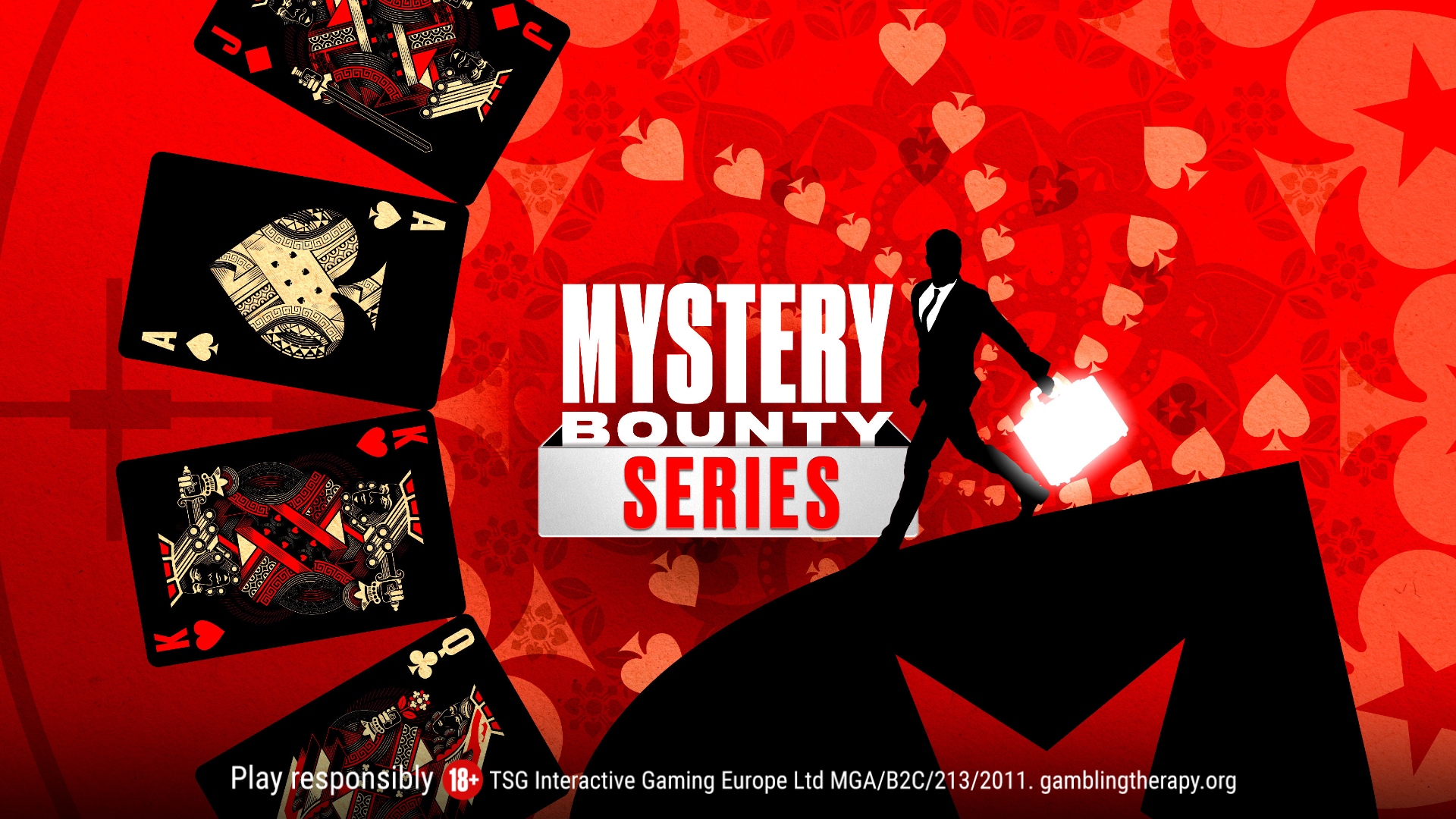
PokerStars Mystery Bounty is a type of poker tournament where players have a chance to win Mystery Bounties as part of the prize pool.
Mystery Bounty tournaments have an initial stage and a final stage:
- Initial stage – players cannot win Mystery Bounties during this stage.
- Final stage – players will win a Mystery Bounty for every player they knock out during this stage, which will usually start when the money bubble bursts. More details about when this stage will start can be seen in the tournament lobby.
A part of the tournament buy-in for Mystery Bounty events goes towards the regular prize pool and another portion contributes to the Mystery Bounty prize pool. See the tournament lobby for more information.
There can be up to nine different tiers of Mystery Bounties, with the highest tier offering the top prize, and lower tiers offering lower-value prizes.
If you knock a player out during the final stage of the tournament, you will receive one of the remaining Mystery Bounties.
Players can win multiple Mystery Bounties – one each time they eliminate a player during the final stage.
Players can win multiple Mystery Bounties with one hand if they knock out more than one opponent. They will win a Mystery Bounty for each player they eliminate during the hand.
If a player is knocked out in a chop hand, all the winning players will split the Mystery Bounty equally.
Players can monitor which Mystery Bounty prizes are still available in the ‘Tournament Info’ widget.
GETTING TO GRIPS WITH THE MATHEMATICS OF BOUNTIES
That leads us on to the next stage. Doing the maths.
This can put off a lot of players. We may be poker players. But that doesn’t automatically make us maths geniuses.
It can get a little tricky working out what money goes where. Also, what that means in terms of odds and all-important equity.
Luckily, we’ve done all the complicated bit for you in our post about getting to grips with the mathematics of bounties.
You’ll find practical examples, all the sums, and even a simple way to remember it all while you’re in the middle of a game. Feel free to write it on the back of your hand.
As the article says, the moment you knock out a player their bounty is split between your bankroll and your own bounty.
Knowing how this changes the way you should play puts you ahead of those other players oblivious to the details.
“We have to aggressively try and knock out as many people as possible, and that means we have to crunch the equity numbers.”
Find out more: Getting to grips with the mathematics of bounties
Back to TopView Other Blogs




